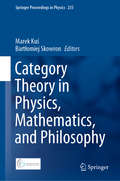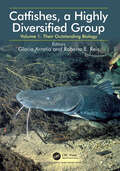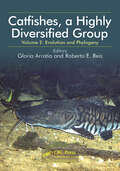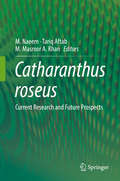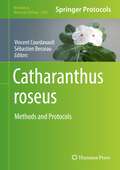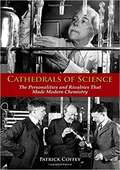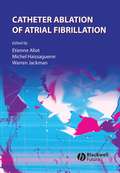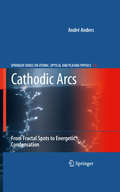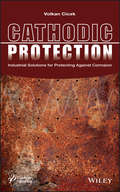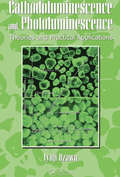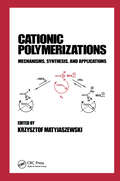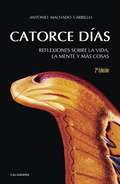- Table View
- List View
Category Theory in Physics, Mathematics, and Philosophy (Springer Proceedings in Physics #235)
by Marek Kuś Bartłomiej SkowronThe contributions gathered here demonstrate how categorical ontology can provide a basis for linking three important basic sciences: mathematics, physics, and philosophy. Category theory is a new formal ontology that shifts the main focus from objects to processes.The book approaches formal ontology in the original sense put forward by the philosopher Edmund Husserl, namely as a science that deals with entities that can be exemplified in all spheres and domains of reality. It is a dynamic, processual, and non-substantial ontology in which all entities can be treated as transformations, and in which objects are merely the sources and aims of these transformations.Thus, in a rather surprising way, when employed as a formal ontology, category theory can unite seemingly disparate disciplines in contemporary science and the humanities, such as physics, mathematics and philosophy, but also computer and complex systems science.
Catenary Optics
by Xiangang LuoThis book offers the first comprehensive introduction to the optical properties of the catenary function, and includes more than 200 figures. Related topics addressed here include the photonic spin Hall effect in inhomogeneous anisotropic materials, coupling of evanescent waves in complex structures, etc. After familiarizing readers with these new physical phenomena, the book highlights their applications in plasmonic nanolithography, flat optical elements, perfect electromagnetic absorbers and polarization converters. The book will appeal to a wide range of readers: while researchers will find new inspirations for historical studies combining mechanics, mathematics, and optics, students will gain a wealth of multidisciplinary knowledge required in many related areas. In fact, the catenary function was deemed to be a “true mathematical and mechanical form” in architecture by Robert Hooke in the 1670s. The discovery of the mathematical form of catenaries is attributed to Gottfried Leibniz, Christiaan Huygens and Johann Bernoulli in 1691. As the founders of wave optics, however, Hooke and Huygens did not recognize the importance of catenaries in optics. It is only in recent decades that the link between catenaries and optics has been established.
Caterpillars in the Middle: Tritrophic Interactions in a Changing World (Fascinating Life Sciences)
by Robert J. Marquis Suzanne KopturCaterpillars are excellent model organisms for understanding how multiple selective forces shape the ecology and evolution of insects, and organisms in general. Recent research using the tools of modern molecular biology, genetics, metabolomics, microbial ecology, experiments conducted at a global level, network analysis, and statistical analyses of global data sets, combined with basic natural history, are yielding exciting new insights into caterpillar adaptations and ecology. The best way to view these research advances is within a framework of tri-trophic interactions. This is a timely topic for research given the central role of caterpillars and plants in the ecology and trophic structure of terrestrial communities. This book is unique in that it contains chapters from a team of experts on a diversity of key topics within caterpillar-plant interactions. This volume brings together contributions by researchers from around the globe, working in both tropical and temperate habitats, and in human-managed and more natural habitats. It is a significant contribution to our understanding of insect biology, and the role that insects, as represented by caterpillars, play in a world increasingly dominated by humans and one in which threats to insect biodiversity are mounting.Chapter 11 is available open access under a Creative Commons Attribution 4.0 International License via link.springer.com.
Catfishes, a Highly Diversified Group: Volume 1: Their Outstanding Biology
by Roberto E. Reis Gloria ArratiaThe order of Catfishes (Siluriformes) is one of the largest in number of families, genera, and species. The group is found in most freshwaters and shallow saltwater bodies around the world. Its extraordinary evolutionary and biogeographic pathways leave many open questions on its origin and large diversification that make its study a complex subject, yet a fascinating field for research. Catfishes, a Highly Diversified Group is divided into two volumes. Volume 1 (Their Outstanding Biology, 14 chapters) aims to rectify the incomplete information on the enormous morphological diversity of the group, special habits and adaptations to specific environments, and morpho-functional characteristics of the catfishes. Volume 2 (Evolution and Phylogeny, 18 chapters) deals with evolutionary mechanisms and major evolutionary trends within Siluriformes, investigating new avenues concerning fossil and extant catfishes and relationships within and among families, using morphological and molecular evidence.
Catfishes, a Highly Diversified Group: Volume 2: Evolution and Phylogeny
by Roberto E. Reis Gloria ArratiaThe order of Catfishes (Siluriformes) is one of the largest in number of families, genera, and species. The group is found in most freshwaters and shallow saltwater bodies around the world. Its extraordinary evolutionary and biogeographic pathways leave many open questions on its origin and large diversification that make its study a complex subject, yet a fascinating field for research. Catfishes, a Highly Diversified Group is divided in two volumes. Volume 1 (Their Outstanding Biology; 14 chapters) aims to rectify the incomplete information on the enormous morphological diversity of the group, special habits and adaptations to specific environments, and morpho-functional characteristics of the catfishes. Volume 2 (Evolution and Phylogeny; 18 chapters) deals with evolutionary mechanisms and major evolutionary trends within Siluriformes, investigating new avenues concerning fossil and extant catfishes and relationships within and among families, using morphological and molecular evidence.
Catfishing on CatNet: A Novel (A CatNet Novel #1)
by Naomi KritzerA Kirkus Reviews 2019 Best of the Year Selection. How much does the internet know about YOU? A thought-provoking near future YA thriller that could not be more timely as it explores issues of online privacy, artificial intelligence, and the power and perils of social networks. <p><p> Because her mom is always on the move, Steph hasn’t lived anyplace longer than six months. Her only constant is an online community called CatNet—a social media site where users upload cat pictures—a place she knows she is welcome. What Steph doesn’t know is that the admin of the site, CheshireCat, is a sentient A.I. When a threat from Steph’s past catches up to her and ChesireCat’s existence is discovered by outsiders, it’s up to Steph and her friends, both online and IRL, to save her. <p> Catfishing on CatNet is a surprising, heartfelt near-future YA thriller by award-winning author Naomi Kritzer, whose short story “Cat Pictures Please” won the Hugo Award and Locus Award and was a finalist for the Nebula.
Catharanthus roseus: Current Research and Future Prospects
by Tariq Aftab M. Masroor A. Khan M. NaeemHistorical uses of Catharanthus roseus in the treatment of diabetes, fever, malaria, regulation of menstrual cycle, throat infection and chest complaints have been reported. Only few plants have the anticancer properties and periwinkle is one of them. The physiologically important and antineoplastic alkaloids, vinblastine and vincristine, are mainly present in leaves and antihypertensive alkaloids are found in roots such as ajmalicine, serpentine and reserpine. Vincristine and vinblastine have extensive use in modern medicine as potential anticancer compounds. Above medicinal properties are worth attracting the attention of plant scientists to increase the secondary metabolites of this plant. The growth and active constituents production of medicinal plants can be altered by the application of several PGRs. The present study explore the role of two well known PGRs namely gibberellic acid and triacontanol to increase the productivity aanticancerous alkaloids in Catharanthus roseus L.
Catharanthus roseus: Methods and Protocols (Methods in Molecular Biology #2505)
by Vincent Courdavault Sébastien BesseauThis volume provides updated technical approaches that have been developed to characterize monoterpene indole alkaloid metabolism in C. roseus from metabolite/gene product localization, alkaloid chemical synthesis, candidate gene prediction, transcription factor characterization up to functional genomic tools based on gene overexpression. Written in the format of the highly successful Methods in Molecular Biology series, each chapter includes an introduction to the topic, lists necessary materials and reagents, includes tips on troubleshooting and known pitfalls, and step-by-step, readily reproducible protocols. Authoritative and cutting-edge, Catharanthus roseus: Methods and Protocols aims to be a guidebook to all researchers working at characterizing alkaloid biosynthesis and more broadly specialized metabolisms
Cathedrals Of Science: The Personalities And Rivalries That Made Modern Chemistry
by Patrick CoffeyIn Cathedrals of Science, Patrick Coffey describes how chemistry got its modern footing-how thirteen brilliant men and one woman struggled with the laws of the universe and with each other. They wanted to discover how the world worked, but they also wanted credit for making those discoveries, and their personalities often affected how that credit was assigned. Gilbert Lewis, for example, could be reclusive and resentful, and his enmity with Walther Nernst may have cost him the Nobel Prize; Irving Langmuir, gregarious and charming, "rediscovered" Lewis's theory of the chemical bond and received much of the credit for it. Langmuir's personality smoothed his path to the Nobel Prize over Lewis. Coffey deals with moral and societal issues as well. These same scientists were the first to be seen by their countries as military assets. Fritz Haber, dubbed the "father of chemical warfare," pioneered the use of poison gas in World War I-vividly described-and Glenn Seaborg and Harold Urey were leaders in World War II's Manhattan Project; Urey and Linus Pauling worked for nuclear disarmament after the war. Science was not always fair, and many were excluded. The Nazis pushed Jewish scientists like Haber from their posts in the 1930s. Anti-Semitism was also a force in American chemistry, and few women were allowed in; Pauling, for example, used his influence to cut off the funding and block the publications of his rival, Dorothy Wrinch. Cathedrals of Science paints a colorful portrait of the building of modern chemistry from the late 19th to the mid-20th century.
Catheter Ablation of Atrial Fibrillation
by Etienne AliotCatheter Ablation of Atrial Fibrillation Edited byEtienne Aliot, MD, FESC, FACC, FHRS Chief of Cardiology, Hôpital Central, University of Nancy, FranceMichel Haïssaguerre, MD Chief of Electrophysiology, Hôpital Cardiologique du Haut-Lévêque, FranceWarren M. Jackman, MD Chief of Electrophysiology, University of Oklahoma Health Science Center, USAIn this text, internationally recognized authors explore and explain the advances in basic and clinical electrophysiology that have had the greatest impact on catheter ablation of atrial fibrillation (AF).Designed to assist in patient care, stimulate research projects, and continue the remarkable advances in catheter ablation of AF , the book covers:the fundamental concepts of AF, origin of signals, computer simulation, and updated reviews of ablation toolsthe present practical approaches to the ablation of specific targets in the fibrillating atria, including pulmonary veins, atrial neural network, fragmented electrograms, and linear lesions, as well as the strategies in paroxysmal or chronic AF or facing left atrial tachycardiasthe special challenge of heart failure patients, the impact of ablation on mortality, atrial mechanical function, and lessons from surgical AF ablationRichly illustrated by numerous high-quality images, Catheter Ablation of Atrial Fibrillation will help every member of the patient care team.
Cathodic Arcs: From Fractal Spots to Energetic Condensation (Springer Series on Atomic, Optical, and Plasma Physics #50)
by André AndersCathodic arcs are among the longest studied yet least understood objects in science. Plasma-generating, tiny spots appear on the cathode; they are highly dynamic and hard to control. With an approach emphasizing the fractal character of cathode spots, strongly fluctuating plasma properties are described such as the presence of multiply charged ions that move with supersonic velocity. Richly illustrated, the book also deals with practical issues, such as arc source construction, macroparticle removal, and the synthesis of dense, well adherent coatings. The book spans a bridge from plasma physics to coatings technology based on energetic condensation, appealing to scientists, practitioners and graduate students alike.
Cathodic Protection: Industrial Solutions for Protecting Against Corrosion
by Volkan CicekA companion to the title Corrosion Chemistry, this volume covers both the theoretical aspects of cathodic protection and the practical applications of the technology, including the most cutting-edge processes and theories. Engineers and scientists across a wide range of disciplines and industries will find this the most up-to-date, comprehensive treatment of cathodic protection available. A superb reference and refresher on the chemistry and uses of the technology for engineers in the field, the book also provides a tremendous introduction to the science for newcomers to the field.
Cathodoluminescence and Photoluminescence: Theories and Practical Applications
by Lyuji OzawaWritten by a senior industry expert with nearly 40 years of hands-on experience, Cathodoluminescence and Photoluminescence: Theories and Practical Applications presents a thorough review of advances, challenges, and recommendations for improving photoluminescent (PL) and cathodoluminescent (CL) phosphor display devices in terms of energy efficiency, image quality, color fidelity, operational lifetime, and production cost.This book traces the development of cathode ray tubes (CRTs), PL and CL phosphor screens, and fluorescent lamps (FL) into modern phosphor display devices. The author relates luminescence phenomena and color to chemical composition, excitation mechanisms, energy conversion efficiencies, and bulk properties of phosphor particles. He also addresses image quality issues such as flickering, smearing, whitening, and contrast. Subsequent chapters focus on powder deposition techniques and the production of phosphor powders themselves. The text describes the necessary raw materials, flux materials, and growth conditions for producing ZnS powders. It provides a quantitative analysis on optimal processes and parameters for ensuring higher quality color and screen resolution. Offering a detailed guide for next-generation scientists and engineers in the field, Cathodoluminescence and Photoluminescence describes current technologies and promising developments for producing higher quality, energy-efficient, and long-lasting phosphor CR and flat CL screen displays.
Cation Binding by Macrocycles: Complexation of Cationic Species by Crown Ethers
by InoueThis reference details the theory and application of cation complexation, including the design and synthesis of various cyclic systems, these materials' use as transport systems, in complexation and selectivity studies by macrocyclic systems, and methodologies for understanding these phenomena. In a
Cationic Polymerizations: Mechanisms, Synthesis & Applications (Plastics Engineering)
by Krzysztof MatyjaszewskiThis unified presentation of cationic polymerization discusses initiation, propagation, transfer, and termination in cationic polymerizations of alkenes and heterocycles. It also elucidates the mechanisms of the reactions involved in all carbocationic and ring-opening polymerizations. It is written by internationally acclaimed experts in their resp
Cationic Surfactants: Analytical and Biological Evaluation (Surfactant Science #53)
by John Cross Edward J. SingerThis work focuses on the environmental availability and effects, toxicological properties and numerous applications of cationic surfactants, detaling the modern analytical processes by which this important class of compounds may be studied. It discusses the types of microorganisms that are susceptible or refractory to the actions of cationic agents.
Cationic Surfactants: Organic Chemistry (Surfactant Science)
by James M. RichmondAuthors from Akzo, Sherex, and Ethyl chemical companies present a comprehensive review of cationic surfactants, emphasizing the organic chemistry aspects. They discuss the preparation, properties, availability, and commercial uses of a wide range of these materials, including aromatic and cyclic var
Catology: The Weird and Wonderful Science of Cats
by Stefan GatesCatology explores the bizarre and very funny world of feline science.Vital questions answered include:Why do cats have a secret second nose?Why don’t cats fart (but dogs do)?Do cats feel guilt, love, happiness or jealousy?Why are cats’ tongues covered in microscopic hooks?Do cats always land on their feet?Why are cats so scared of cucumbers?Why do cats purr both when happy and when distressed?How do you interpret cat language?Packed with fascinating facts, quirky scientific revelations and weird stories about our furry friends, Catology offers a secret glimpse inside the feline body and mind.
Catorce días: Reflexiones sobre la vida, la mente y más cosas
by Antonio Machado CarrilloReflexiones sobre la vida, la mente y más cosas. Antonio Machado Carrillo es un biólogo canario que un buen día marchó a Laos y se puso a escribir durante «catorce días». <P><P>El producto de este encuentro consigo mismo es una mezcla de cuaderno de viaje, ensayo filosófico, libro de divulgación y legado intelectual difícil de etiquetar, pero que no deja indiferente al lector. <P>Explica y razona el sentido de la vida (materia viva) y de la mente (materia pensante) como fenómenos cósmicos; aborda la importancia que la información tiene en la evolución del universo y en la de los seres vivos; trata de los instintos y logros culturales de nuestra especie vista como amalgama psicobiológica; del futuro de la naturaleza en una psicosfera, de la humanina, de los riesgos del ecofascismo, de los males de la abundancia, de la infoxicación, de las creencias, de la razón de vivir o ikigai de las personas, y de más cosas como se indica en el título. <P>Es un libro generoso con el que se aprende; que invita a la reflexión, o tal vez la imponga.
Cats Are Not Peas: A Calico History Of Genetics (Ak Peters Series)
by Laura L. GouldAfter she accidentally adopted a calico cat that turned out to be a male, Laura Gould was seized by curiosity. <P><P>For there to be no male calicos at all would be understandable - it was their extreme rarity that was the puzzle. <P><P>Gould, an expert in linguistics with no previous training in genetics, decided to learn how this could be. <P><P>Her research took her through the great discoveries in genetics, from Mendel's studies of inheritance in peas through the discovery of the chromosome and the role of DNA - all seen from the little-known and unheralded viewpoint of the pivotal role played by cats as experimental subjects in this epic drama. <P><P> Narrated with inimitable grace and wit, this is the story of an unrecognized chapter in the history of science.
Cats React to Outer Space Facts
by Izzi HowellCats React is back for a second instalment! Share in the wonderment of space with a crew of crazy cats and measure your amazement, awe and disgust alongside their furry feline faces!Like every topic, space becomes more interesting when cats are involved. Cats React to Space Facts is an engaging and fun way to understand our universe. It's just purrfect! Bitesize text, fun photos, diagrams, dollops of humour and a react-o-meter all help to make science memorable and fun to learn.This book is a great gift for cat lovers and science students aged 7 and beyond, covering physics in a unique way.
Cats React to Science Facts
by Izzi HowellWINNER OF THE ROYAL SOCIETY YOUNG PEOPLE'S BOOK PRIZE 2020Share in the wonderment of science with a crew of crazy cats and measure your amazement, awe and disgust alongside their furry feline faces!Like every topic, science becomes more interesting when cats are involved. Cats React to Science Facts is an engaging and fun way to understand the world of science. It's just purrfect! A vast cast of feline friends take us on a tour of the core areas of science from outer space and the human body, to forces and materials. Bitesize text, fun photos, diagrams, dollops of humour and a react-o-meter all help to make science memorable and fun to learn.This book is a great gift for cat lovers and science students aged 7 and beyond, covering key science topics in a unique way.
Cats React to Science Facts
by Izzi HowellLet´s face it: Like every topic, science becomes more interesting when cats are involved!Every spread of this book introduces a STEM topic related to physical science, biology, astronomy or the human body, and a furry cat uses a scale to determine if the fact is Wow! or No Way! or OMG! Or Gross! Or Mind-Blowing! Packed with key science topics, hilarious jokes, puns and cats, and building on the popularity of online cat videos ... kids will find this book is just purr-fect!
Cats and Conservationists: The Debate Over Who Owns the Outdoors (New Directions in the Human-Animal Bond)
by Anna L. Peterson Dara M. WaldCats and Conservationists is the first multidisciplinary analysis of the heated debate about free-roaming cats. The debate pits conservationists against cat lovers, who disagree both on the ecological damage caused by the cats and the best way to manage them. An impassioned and spirited conflict, it also sheds light on larger questions about how we interpret science, incorporate diverse perspectives, and balance competing values in order to encourage constructive dialogue on contentious social and environmental issues. <p><p>On one side of the cat debate stand many environmentalists, especially birders and conservation organizations, who believe that outdoor cats seriously threaten native wildlife. On the other side are many animal welfare advocates, who believe that outdoor cats generally do not pose a major ecological threat and that it is possible for cats and wildlife to coexist. They believe that it is possible, mainly through trap-neuter-return projects (TNR), to keep free-roaming cat populations in check without killing large numbers of cats. <p><p>Careful analysis suggests that there remain important questions about the science on both cat predation and TNR effectiveness. Yet both sides of the conflict insist that the evidence is clear-cut. This false certainty contributes to conflict between conservationists and cat lovers, and obscures common goals that could generate constructive discussions and collaborative efforts among scientists, policymakers, conservationists, and animal welfare advocates. Cats and Conservationists aims to facilitate such collaboration in order to manage outdoor cats and minimize the damage they cause. It also offers models for constructive debates about the public role of science in other polarized public conflicts over science and environmental topics.
Cats in Question: The Smithsonian Answer Book
by John Seidensticker Art Wolfe Susan LumpkinWhat are cats? How do cats hunt? Do wild cats like catnip? Do cats dream? Cats in Question, a new book in Smithsonian's highly successful "In Question" series, offers authoritative and engaging answers to the thousands of questions about cats that Smithsonian scientists receive annually. All of the world's cats are here, from fearsome predators such as lions and tigers, to mysterious hunters such as leopards and jaguars, to cuddly pets such as domestic cats. More than 100 breathtaking photographs by acclaimed photographer Art Wolfe illustrate the questions on cat facts, cat evolution and diversity, and cats and humans.
